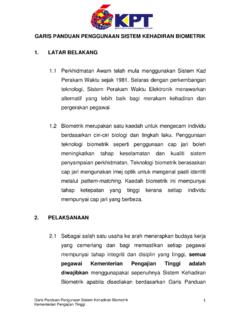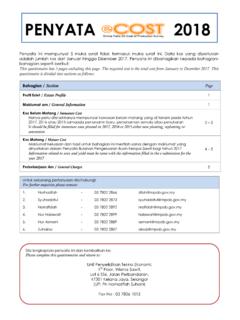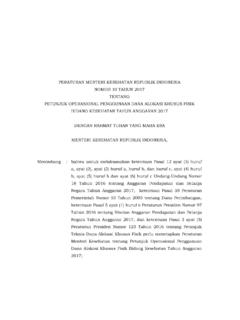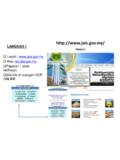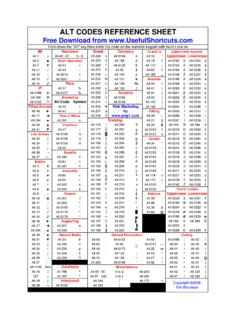Transcription of Public Health Classics - WHO
1 792 Bulletin of the World Health Organization | October 2005, 83 (10) Public Health ClassicsThis section looks back to some ground-breaking contributions to Public Health , reproducing them in their original form and adding a commentary on their significance from a modern-day perspective. Robyn M. Lucas and Anthony J. McMichael review The environment and disease: association or causation? by Sir Austin Bradford Hill on establishing relationships between illness and conditions of work or living. The original paper is reproduced by permission of The Royal Society of Medicine Press Limited ( ).Association or causation: evaluating links between environment and disease Robyn M.
2 Lucas1 & Anthony J. McMichael2 Epidemiological studies typically examine associations between an exposure variable and a Health outcome. In assessing the causal nature of an observed association, the Bradford Hill criteria have long provided a background framework in the words of one of Bradford Hill s closest colleagues, an aid to thought (1). First published exactly 40 years ago, these criteria also provided biomedical relevance to epidemiological research and quickly became a mainstay of epidemiological textbooks and data interpretation (2). Their checklist nature suited the study of simple, direct causation by disciplines characterized by classic scientific and mathematical diseases have a multifactorial pathogenesis, but the conceptualization of their causation varies by discipline.
3 While it is scientifically satisfying to elucidate the many component causes of an illness, in Public Health research the more impor-tant emphasis is on the discovery of necessary or sufficient causes that are amenable to intervention. Even so, over the four decades since Bradford Hill s paper appeared, the range of multivariate, multistage and multi-level research questions tackled by epidemiologists has evolved, as have their statistical methods and their engagement in wider-ranging interdisci-plinary research. Within that context it is often not appropriate to seek the discrete cause or causes of a disease, but rather to identify a complex of interrelated and often interacting fac-tors that influence the risk of disease (1).
4 This complicates the assessment of general context within which Bradford Hill devel-oped his ideas about causal inference warrants brief review here. Most epidemiological research is non-experimental, being conducted in an inherently noisy environment in free-living populations. For example, the quality of the measurement of exposure and of Health status is usually less than in controlled clinical trials or laboratory-based studies (measurement error); there are potential confounding variables that are statistically associated with the exposure variable of interest while also predictive of the Health outcome in their own right, and these covariates must be controlled for; the sample of persons 1 National Centre for Epidemiology and Population Health , The Australian National University, Canberra, ACT 0200, Australia.
5 Correspondence should be sent to this author (email: National Centre for Epidemiology and Population Health , The Australian National University, Canberra, No. 04-016048studied may not provide true information about the relation-ship between exposure and outcome in the source population, with respect either to the relationship that the sample actually displays (selection bias) or apparently displays (classification bias). Epidemiologists therefore seek research settings and study designs that maximize the signal-to-noise sources of noise, intrinsic to much epidemiological research, require one to proceed cautiously in making causal inference.)
6 Once sufficient studies have been done, in diverse settings, and adequately limiting random error (an intrinsic property of a stochastic universe), systematic error (bias) and logical error (confounding), then the causal nature of observed associations can reasonably be , though, that particular phrase: causal nature . Causation is an interpretation, not an entity; it should not be reified. The 18th-century Scottish philosopher David Hume pointed out that causation is induced logically, not observed empirically (3). Therefore we can never know absolutely that exposure X causes disease Y. There is no final proof of causation: it is merely an inference based on an observed conjunction of two variables (exposure and Health status) in time and space.
7 This limitation of inductive logic applies, of course, to both experimental and non-experimental the mid-20th century, the philosopher Karl Popper offered a solution to this problem of reliance on induc-tion. He stressed that science progresses by rejecting or modify-ing causal hypotheses, not by actually proving causation. While flirting briefly with Popper s ideas in the 1970s (4), epidemiolo-gists have generally taken a practical data-based approach to the notion of causation, comfortably embracing Bradford Hill s criteria of causality. In general, these seem well suited to the mostly non-experimental, bias-prone, confounding-rich nature of epidemiological research.
8 These nine criteria, or guidelines, lay particular emphasis upon the temporality of the relationship, its strength, the presence of a plausible dose response relation-ship, the consistency of findings in diverse studies, and coher-ence with other disciplinary findings and biomedical theory. 793 Bulletin of the World Health Organization | October 2005, 83 (10) Public Health ClassicsRobyn M. Lucas & Anthony J. McMichael. Association or causation: evaluating links between environment and disease Rather than proposing absolute criteria, Bradford Hill consid-ered these as aspects of the association between an exposure and an outcome that we especially consider before deciding that the most likely interpretation of it is causation.
9 Bradford Hill s ideas about causal inference were formu-lated in the heady early years of the rise of noncommunicable disease epidemiology, which was essentially a post-Second World War phenomenon. His own experience included, in particular, the first definitive controlled clinical trial of streptomycin in the treatment of tuberculosis, in the late 1940s (5) and the early studies of cigarette smoking and lung cancer, principally the British doctors cohort study (6). Other early successes in non-experimental epidemiological studies of noncommunicable diseases included those that entailed substantial, quantifiable occupational exposures, for example to ionizing radiation (7), asbestos (8) and nickel (9).
10 It is not surprising that, against that background, the challenge seemed not so much that of elucidating and apportioning complex causality but, more fundamentally, of inferring simple, rela-tively direct-acting Hill recognized the importance of moving from association to causation as a necessary step for taking preventive action against environmental causes of disease. But there are questions about the universal applicability of his classic criteria. How valid are they in the assessment of multifactorial causality? Are they useful in a widening research agenda within which, for example, we try to identify and quantify the effects of more distal, often indirectly acting determinants of Health such as factors related to socioeconomic status, the effects of urban design on physical activity levels and the incidence of obesity, or the effects of ongoing climate change on risk of death from flooding?










